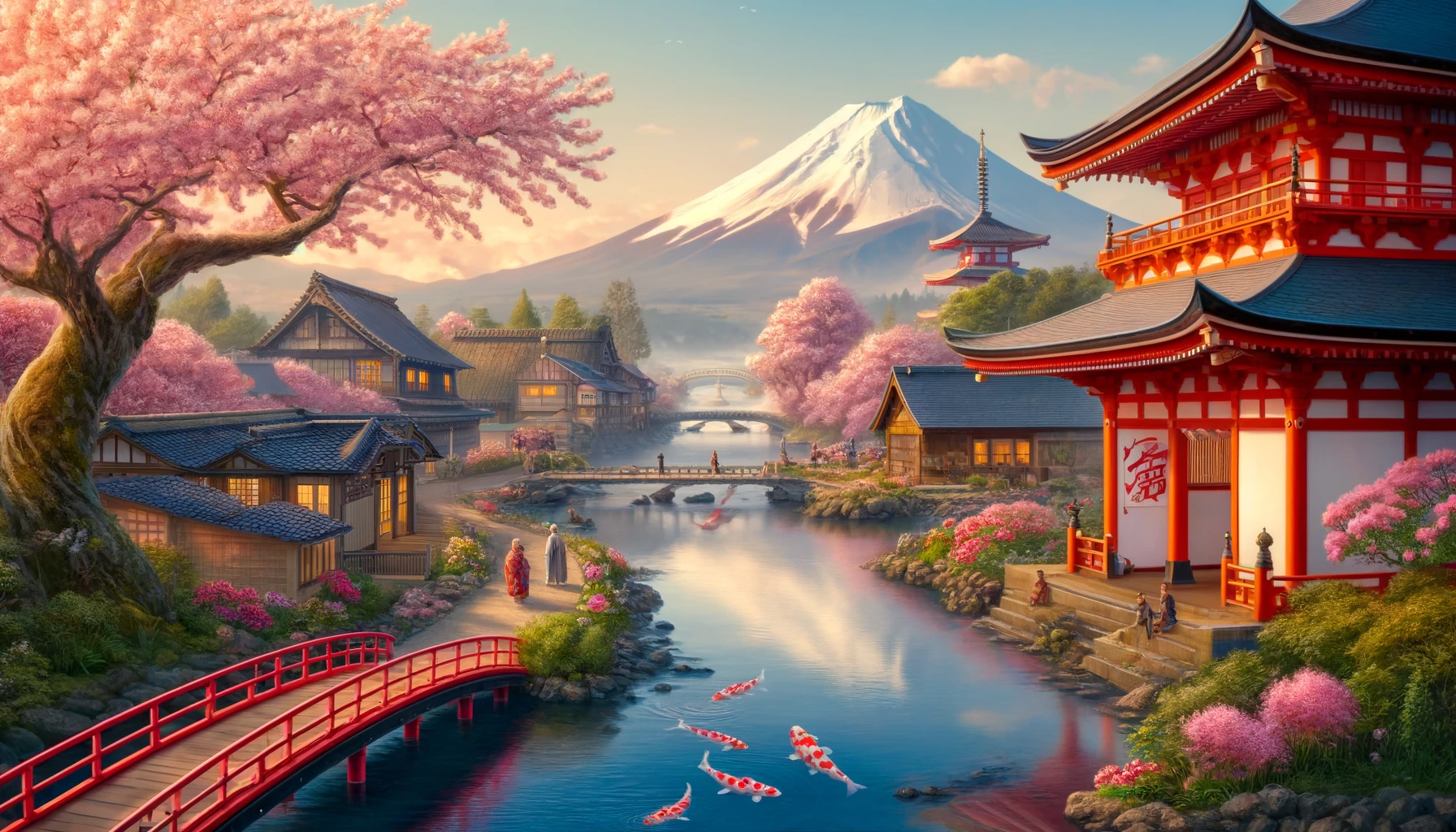
Japan: The Land Of The Rising Sun
Kay
- 0
Here you are at the Land of the Rising Sun! Where east-meets-west, Japan boasts ancient traditions and the latest technology, making it an experience like no other. History buff, tech nerd, food lovers – Japan is a paradise, to say the least.
A Glimpse of Japan
Geography
Japan is a collection of 6,852 islands that sit in East Asia. The four largest islands – Honshu, Hokkaido, Kyushu and Shikoku – make up approximately 97 per cent of the land area and possess extraordinary natural beauty because so much of Japan consists of mountainous terrain and is surrounded by beautiful coastlines.
Population
Japan has a population of roughly 126 million, which ranks it as the eleventh most populous country in the world. However, Despite its density, both population and infrastructure, Japan’s clean cities and advanced infrastructures rank it as one of the most advanced nations.
Historical Overview
Ancient Japan
The beginnings of the history of Japan, which has a continuously maintained traditional culture for more than a millennium and a half, go back to the Jomon period roughly 14,000 years ago when pottery of a distinctive style was made.
Feudal Japan
Japan obtained much of its modern structure thanks to the feudal era characterized by the samurai and the shogunate that ruled that time, which resulted in much of today’s Japanese traditions, such as the tea ceremonies and martial arts.
Modern Japan
The Meiji Restoration in 1868 ushered in modern-day Japan after nearly 12 centuries of feudal rule, followed by an explosion of industrialization and economic growth after 1945 that made the country an Economic superpower and one of the most powerful nations on Earth.
Cultural Heritage
Traditional Arts
As well as its traditional schools and artistic pursuits (the tea ceremony, calligraphy, ikebana and more), the country has a deep appreciation for the beauty of the moment, thanks to its reverence for aesthetics and mindful practice.
Festivals and Events
Like every other season of the year, Japan has its own festival: from cherry blossom viewing parties (hanami) to the great Kyoto festival Gion Matsuri.
Cuisine
What is often hailed as the world’s most diverse and beautiful cuisine can be found in Japan. Sushi, often the first thing non-Japanophiles think of, is just one of a huge number of delicious traditional dishes – from ramen, to tempura. The different regions of Japan each have their own specialties, so the joyful discovery is endless.
Technological Advancements
Innovation Hub
Japan has always had a reputation for being very innovative. Japan is the world leader in robotics and in the automotive industry. The country is full of advanced technologies. Tokyo and Osaka are famous for their research and development centers.
Leading Industries
The biggest are in electronics, automotive and robotics: the global giants Toyota, Sony and Panasonic are only the tip of the iceberg. Japan commits itself constantly to high-quality, market-leading innovation.
Tourism in Japan
Must-Visit Cities
In Tokyo, the futuristic capital, cutting-edge shopping zones collide with the ancient backstreets of chic Asakusa. Further south, Kyoto has historic temples and gardens, while lively Osaka is home to the nation’s largest population and an energetic nightlife.
Natural Wonders
And there’s the picture-postcard scenery – Mount Fuji and the bamboo forests of Arashiyama, national parks and onsens (hot springs), perfect destinations for a bit of rural isolation to cleanse the soul from the urban grime.
Conclusion
From the ancient temples of Kyoto to the robot cafes of Tokyo, Japan melds the old with the new. It is a place where you can wander along village paths or get lost in the urban madness of Tokyo.
Must-Visit Cities
Tokyo: The Pulsating Heart of Japan
Tokyo, the capital, is a wonderful place where old and new meet: traditional Japan and futuristic technology. Here are some of its highlights:
Shibuya Crossing
The world’s busiest pedestrian crossing and a symbol of the high energy level in Tokyo.
Tokyo Tower and Skytree
These towering structures offer panoramic views of the sprawling cityscape.
Asakusa and Senso-ji Temple
It’s hard to get more traditional than this, Japan’s oldest temple and its surrounding shopping street, Nakamise-dori.
Akihabara
tech pervs and anime nerds paradise. Electronics shops and themed cafes.
Kyoto: The Historical and Cultural Jewel
Kyoto, known as the ancient capital of Japan, is one of the most important places for traditional Japanese culture. It exhibits the remains of temples, shrines and gardens that take you back to the past.
You have probably already heard about Fushimi Inari Shrine. With its symbolic red torii gates, this popular shrine appears thousands of times in images of Japan. It is an amazing, religious place.
Kinkaku-ji (Golden Pavilion)
Shingon and Rinzai temples’ main buildings are coated in gold leaf and reflected in ponds.
Lofty stalks of bamboo seem to reach towards the sky in the famous Arashiyama Bamboo Grove, making you feel like you’re in another realm.
Gion District
Essentially the incarnation of Hanami-koji street, Gion specializes in wooden machiya houses. This is the place to go if you want a glancing glimpse of geishas, even if your chances are slim.
Osaka: The Kitchen of Japan
Osaka is a nightlife mecca, backed by its densely packed streets full of yatai stalls and friendly people. There is definitely more to it than meets the eye – this city just knows how to party.
Dotonbori
Lots of neon lights, food stalls and the amazing atmosphere.
Osaka Castle
View the historical castle, surrounded by greenery in a classic style, while gaining an insight into Japan’s feudal days.
Universal Studios Japan
A great family attraction plus one of Tokyo’s biggest theme parks, Universal focuses on movies and series.
Kuromon Ichiba Market
Fresh fish, produce and delicious street food. Food lovers’ paradise!
Hiroshima: A City of Peace and Reflection
Japan’s historic capital of Hiroshima, the site of an atomic bombing attended with the great loss of life during the Second World War, has become both a symbol of world peace and a poignant reminder of the human toll wrought by that conflict and warfare in general.
Hiroshima Peace Memorial Park
The park dedicated to the bomb’s victims and the pursuit of world peace is a monument to both mourning the past and advocating global peace.
Atomic Bomb Dome
what the interior of one of the city buildings must have looked like after the blast.
Miyajima Island
The gate there is more famous than the actual shrine. This is another popular tourist spot not too far from Hiroshima.
Nara: The Ancient Capital
Narajapan’s first permanent capital is known for its many historic treasures and stunning natural beauty.
Hundreds of tame yet wild deer roam free in Nara Park. They are friendly to visitors – if they don’t stay too close.
Todai-ji Temple
The largest bronze statue of the Buddha rests here. Also a masterpiece of architecture.
Kasuga Taisha
The gorgeous Shinto shrine with thousands of bronze and stone lanterns all around.
Sapporo: The Gateway to Hokkaido
Sapporo, on the northern island of Hokkaido, is Japan’s fifth-largest city. Although it is an urban center with all that the term suggests, it also retains much of its natural beauty.
Sapporo Snow Festival
Held every February, it features spectacular ice and snow sculptures.
Odori Park
Why not go for a walk in this green area in the center of the city.
Sapporo Beer Museum
Check out an exhibition on how Japan’s oldest beer brand was made, and enjoy tastings as well.
Mount Moiwa
A view of the city from above. It is a very popular spot where people come at night time.
Fukuoka: The Friendly Gateway to Asia
Fukuoka on the northern shore of Kyushu has the best people in the country – and the nicest food.
Hakata Ramen
Try this local specialty, characterized by its rich pork bone broth.
Canal City Hakata
a shopping and entertainment mall with a canal running through it.
Fukuoka Castle Ruins
This is the remains of the castle at Fukuoka, the old capital of Kyushu in pre-Tokugawa Japan. Take a stroll around the base of the hill through Maizuru Park.
Yokohama: The Cosmopolitan Port City
Culturally and visually, Yokohama shows signs of life that are more attractive and relaxed than Tokyo’s, as it is only minutes away by trains that rattle along the famous Hakone line – perfect for a weekend by the water.
Minato Mirai 21
A futuristic seaside urban area with shopping, dining, and entertainment options.
Yokohama Chinatown
The largest Chinatown in Japan, bustling with vibrant shops and eateries.
FAQs
What is the best time to visit Japan?
Which time of year would you recommend for visiting Japan? When the weather is pleasant in spring(March to May) and autumn (September to November), there are so many beautiful things to see in nature. The foliage is gorgeous and overall the landscape is lovely.
Do I need to learn Japanese to travel in Japan?
Though it’s nice to pick up a little Japanese, loads of signs and menus are in English anyway, and locals are usually really helpful to tourists.
What are some must-try Japanese dishes?
Oishī desu ne. Sushi, ramen, tempura, sashimi okonomi-yaki, karē raisu, wakame saalad, zenzai, manjū, yōkan desu. Nihon no tabemono wa mazō ka? – ‘You should eat sushi, ramen, tempura, sashimi, okonomiyaki and so on. Fish and shellfish, beef, eggs, pickled vegetables, tofu, miso, seaweed, rice, soba noodles, udon noodles, jan – it’s all excellent. What should you eat in Japan?’
Is Japan expensive to visit?
Yes, while it is possible that Japan can be expensive, there are ways for us to stay within budget, like staying at budget hotels, purchasing transportation passes, and even street food can be delicious and cheap!
What are some unique souvenirs to bring back from Japan?
Perhaps gifts from Japan such as kimonos, tea sets, chopsticks or candies and snacks that are difficult to get abroad.
Samsung Galaxy Z Fold2 LG Velvet iPhone 11 LG V60 ThinQ iPhone 11 LG V60 ThinQ Samsung Note 20 LG K40 iPhone SE Samsung Galaxy A51


